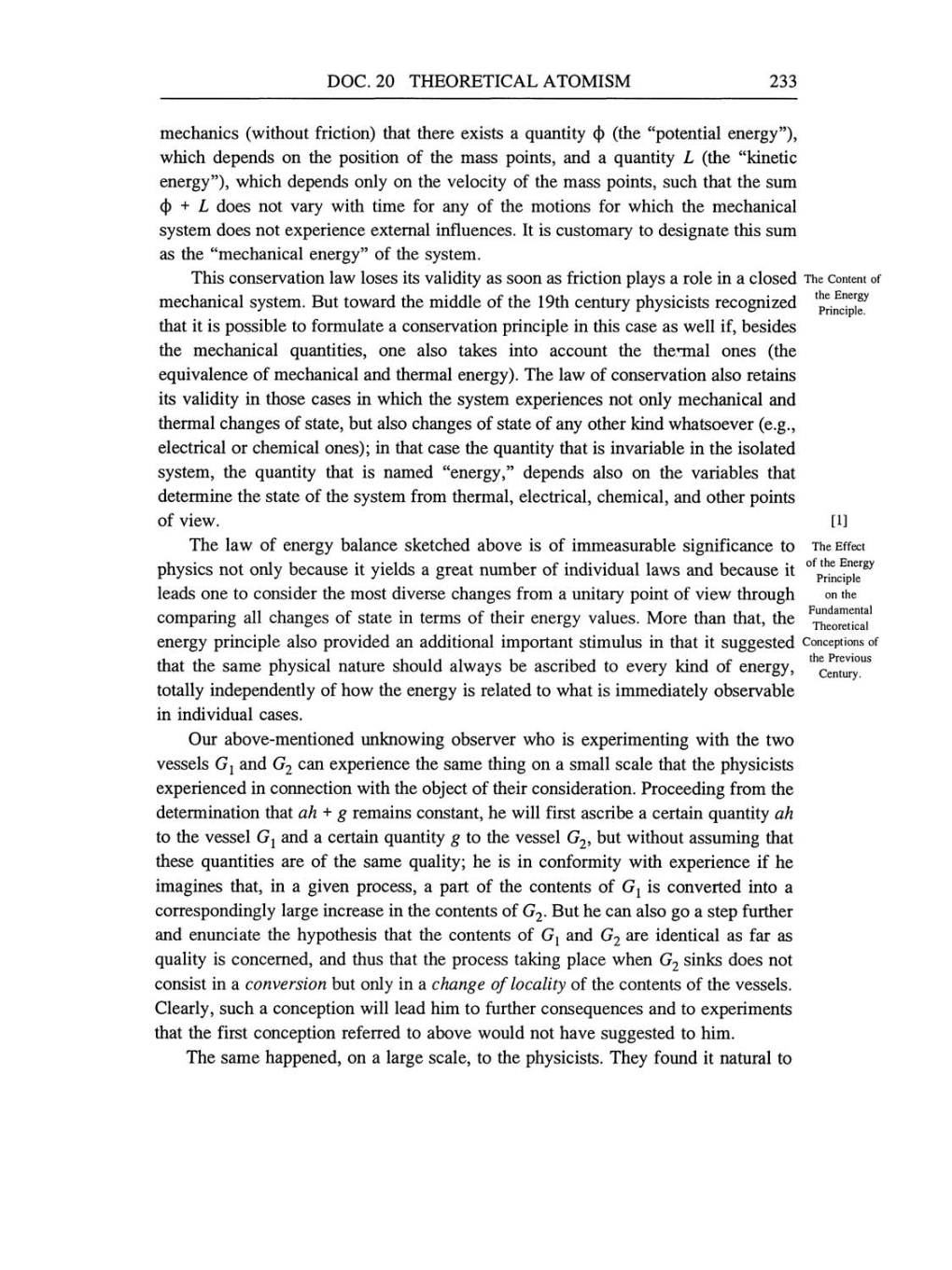DOC. 20 THEORETICAL ATOMISM
233
mechanics
(without friction)
that there exists
a quantity
(J)
(the
"potential energy"),
which
depends on
the
position
of the
mass
points,
and
a
quantity
L
(the
"kinetic
energy"),
which
depends only
on
the
velocity
of the
mass
points,
such that the
sum
c\
+
L
does
not
vary
with time for
any
of the motions for which the mechanical
system
does
not
experience
external influences.
It is
customary
to
designate
this
sum
as
the "mechanical
energy"
of the
system.
This conservation
law
loses
its
validity as soon
as
friction plays
a
role
in a
closed
mechanical system. But toward the middle of the
19th
century physicists recognized
that
it is
possible
to
formulate
a
conservation principle
in this
case
as
well
if,
besides
the mechanical quantities, one also takes into account the thermal ones (the
equivalence of mechanical and thermal energy). The
law
of conservation also retains
its
validity in those cases
in
which the system experiences not only mechanical and
thermal changes of
state,
but
also
changes of state of
any
other kind whatsoever
(e.g.,
electrical
or
chemical
ones); in
that
case
the
quantity
that
is
invariable
in
the isolated
system,
the
quantity
that is named
"energy," depends
also
on
the variables that
determine the
state
of the
system
from
thermal, electrical, chemical,
and other
points
of view.
[1]
The law of energy balance sketched above
is
of immeasurable significance
to
physics not only because
it
yields
a
great number of individual laws and because
it
leads one
to
consider
the
most diverse changes from
a
unitary point of view through
comparing
all
changes of state
in
terms of their energy values. More than that, the
energy principle also provided
an
additional important stimulus
in
that
it
suggested
that the same physical nature should always
be
ascribed
to
every kind of energy,
totally independently of how the energy
is
related
to
what
is
immediately observable
in
individual cases.
Our above-mentioned
unknowing
observer who
is
experimenting
with the
two
vessels
G1
and
G2
can
experience
the
same
thing
on a
small scale that the
physicists
experienced
in connection with the
object
of their consideration.
Proceeding
from the
determination that ah
+
g
remains
constant,
he will first ascribe
a
certain
quantity
ah
to
the vessel
G1
and
a
certain
quantity g
to
the vessel
G2,
but without
assuming
that
these
quantities
are
of the
same quality;
he
is
in
conformity
with
experience
if he
imagines
that,
in
a given process, a part
of the
contents
of
G1
is converted into
a
correspondingly
large
increase
in
the
contents
of
G2.
But he
can
also
go a
step
further
and enunciate the
hypothesis
that the
contents
of
G1
and
G2
are
identical
as
far
as
quality
is concerned,
and thus that the
process taking place
when
G2
sinks does
not
consist
in
a
conversion but
only
in
a
change
of
locality
of the
contents
of the vessels.
Clearly,
such
a conception
will lead him
to
further
consequences
and
to
experiments
that the first
conception
referred
to
above would
not have
suggested
to
him.
The
same happened, on a large
scale, to
the
physicists. They
found
it
natural
to
The Content of
the Energy
Principle.
The Effect
of the Energy
Principle
on the
Fundamental
Theoretical
Conceptions of
the Previous
Century.
